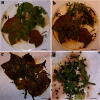Anthocyanin accumulation enhanced in Lc-transgenic cotton under light and increased resistance to bollworm
- PMID: 26941851
- PMCID: PMC4761005
- DOI: 10.1007/s11816-015-0382-3
Anthocyanin accumulation enhanced in Lc-transgenic cotton under light and increased resistance to bollworm
Abstract
Breeding of naturally colored cotton fiber has been hampered by the limited germplasm, an alternative way is to use transgenic approach to create more germplasm for breeding. Here, we report our effort to engineer anthocyanin production in cotton. The maize Lc gene, under the control of the constitutive 35S promoter, was introduced into cotton through genetic transformation. Our data showed that the expression of the Lc gene alone is sufficient to trigger the accumulation of anthocyanin in a variety of cell types including fiber cells in cotton. However, the accumulation of colored anthocyanin in cotton fibers requires the participation of light signaling. These data indicate that it is feasible to engineer colored fibers through transgenic approach in cotton. Furthermore, we showed that the Lc-transgenic cotton plants are resistant to cotton bollworm. These transgenic plants are, therefore, potentially useful for cotton breeding against cotton bollworm.
Keywords: Anthocyanin; Cotton fiber; Gossypium hirsutum; Lc gene.
Figures






Similar articles
-
Over-expression of the red plant gene R1 enhances anthocyanin production and resistance to bollworm and spider mite in cotton.Mol Genet Genomics. 2019 Apr;294(2):469-478. doi: 10.1007/s00438-018-1525-3. Epub 2019 Jan 2. Mol Genet Genomics. 2019. PMID: 30604069
-
Functional analysis of GhCHS, GhANR and GhLAR in colored fiber formation of Gossypium hirsutum L.BMC Plant Biol. 2019 Oct 29;19(1):455. doi: 10.1186/s12870-019-2065-7. BMC Plant Biol. 2019. PMID: 31664897 Free PMC article.
-
A Combinational Approach of Enhanced Methanol Production and Double Bt Genes for Broad Spectrum Insect Resistance in Transgenic Cotton.Mol Biotechnol. 2019 Sep;61(9):663-673. doi: 10.1007/s12033-019-00192-4. Mol Biotechnol. 2019. PMID: 31228008
-
Current status of genetic engineering in cotton (Gossypium hirsutum L): an assessment.Crit Rev Biotechnol. 2014 Jun;34(2):144-60. doi: 10.3109/07388551.2012.743502. Epub 2012 Nov 28. Crit Rev Biotechnol. 2014. PMID: 23190258 Review.
-
Cotton bollworm resistance to Bt transgenic cotton: a case analysis.Sci China Life Sci. 2010 Aug;53(8):934-41. doi: 10.1007/s11427-010-4045-x. Epub 2010 Sep 7. Sci China Life Sci. 2010. PMID: 20821292 Review.
Cited by
-
Changes at a Critical Branchpoint in the Anthocyanin Biosynthetic Pathway Underlie the Blue to Orange Flower Color Transition in Lysimachia arvensis.Front Plant Sci. 2021 Feb 22;12:633979. doi: 10.3389/fpls.2021.633979. eCollection 2021. Front Plant Sci. 2021. PMID: 33692818 Free PMC article.
-
Anthocyanins in metabolites of purple corn.Front Plant Sci. 2023 Apr 6;14:1154535. doi: 10.3389/fpls.2023.1154535. eCollection 2023. Front Plant Sci. 2023. PMID: 37089635 Free PMC article. Review.
-
Ectopic expression of Lc differentially regulated anthocyanin biosynthesis in the floral parts of tobacco (Nicotiana tobacum L.) plants.Bot Stud. 2016 Dec;57(1):24. doi: 10.1186/s40529-016-0138-6. Epub 2016 Sep 8. Bot Stud. 2016. PMID: 28597434 Free PMC article.
-
Effect of Light and Dark on the Phenolic Compound Accumulation in Tartary Buckwheat Hairy Roots Overexpressing ZmLC.Int J Mol Sci. 2021 Apr 29;22(9):4702. doi: 10.3390/ijms22094702. Int J Mol Sci. 2021. PMID: 33946760 Free PMC article.
-
Colored Corn: An Up-Date on Metabolites Extraction, Health Implication, and Potential Use.Molecules. 2021 Jan 2;26(1):199. doi: 10.3390/molecules26010199. Molecules. 2021. PMID: 33401767 Free PMC article. Review.
References
-
- Beasley CA, Ting IP. Effects of plant growth substances on in vitro fiber development from unfertilized cotton ovules. Am J Bot. 1974;61:188–194. doi: 10.2307/2441189. - DOI
-
- Boase MR, Bradley JM, Borst NK. Genetic transformation mediated by Agrobacterium tumefaciens of florists’ chrysanthemum (Dendranthema × Grandiflorum) cultivar “Peach Margaret”. In Vitro Cell Dev Biol. 1998;34:46–51. doi: 10.1007/BF02823122. - DOI
LinkOut - more resources
Full Text Sources
Other Literature Sources
